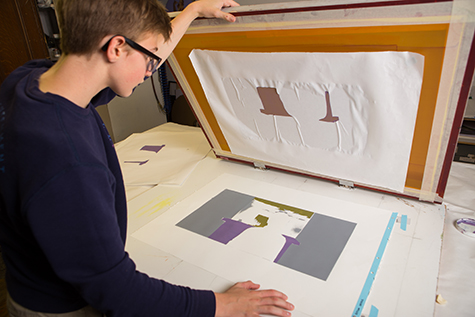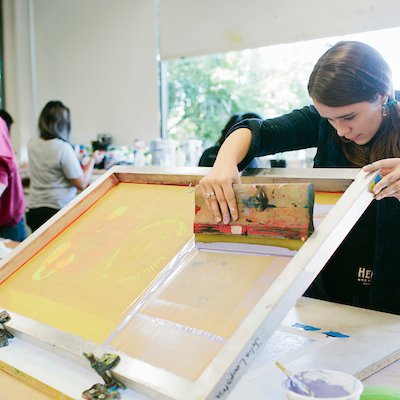Discover the Different Kinds Of Screen Printing Techniques for Your Next Task
Screen printing uses a varied variety of methods that can improve any kind of imaginative project. From standard techniques like serigraphy to contemporary technologies such as direct-to-garment printing, each approach has its one-of-a-kind benefits. Specialized choices, consisting of eco-friendly and metallic inks, present much more opportunities. Recognizing these techniques can substantially affect the last outcome. Nevertheless, the obstacle hinges on picking the most appropriate approach for certain requirements and wanted results. What elements should one think about?

The Fundamentals of Screen Printing
Although screen printing might appear facility, it is basically an uncomplicated procedure that entails moving ink with a mesh screen onto different surfaces. The strategy starts with the production of a pattern, which specifies the style to be printed. This stencil is attached to a mesh screen, commonly made of polyester or nylon. When the pattern remains in location, ink is used to the screen and pressed with the mesh making use of a squeegee, resulting in the preferred pattern being printed on the underlying material.
Screen printing can be done on a large range of substratums, including plastic, paper, and textile, making it a functional choice for various tasks. The procedure enables intricate designs and vibrant shades, making it popular in sectors such as marketing, art, and style. Understanding these basics gears up individuals with the foundational understanding called for to explore advanced techniques in screen printing.
Standard Screen Printing Techniques
Traditional screen printing methods have actually been utilized for centuries, maintaining the workmanship and artistry of this technique. This approach uses a mesh screen to transfer ink onto a substratum, such as material or paper, enabling vibrant and lasting layouts. The procedure begins with producing a pattern, which obstructs certain areas of the screen to manage where the ink will certainly be applied.
One prominent technique is serigraphy, commonly used for minimal editions and artistic prints. One more is the usage of water-based inks, which are environmentally friendly and give a soft feeling on textiles - 10:9 Design reviews. Furthermore, standard techniques can consist of hands-on printing, where artisans use ink with a squeegee, ensuring precision and interest to detail
These strategies stay valued in the sector for their tactile high quality and the one-of-a-kind textures they create, interesting both customers and creators that appreciate the heritage of screen printing.
Digital Screen Printing Innovations
As the demand for faster production and personalization in the printing sector has surged, electronic screen printing innovations have become a game-changer. This modern technology mixes traditional screen printing approaches with digital procedures, enabling quick prototyping and intricate layouts that were formerly tough to achieve. One considerable innovation is the introduction of direct-to-garment (DTG) printing, which facilitates top notch, full-color prints on numerous fabrics without the need for screens. In addition, advancements in ink formulas have caused environment-friendly choices that maintain vivid shades while reducing environmental effect. The usage of automated systems additionally improves manufacturing, minimizing labor expenses and enhancing precision. These innovations not only satisfy tiny batch orders and individualized designs but additionally permit quicker turn-around times, making them suitable for businesses focused on conference consumer needs in a busy market. Digital screen printing, consequently, stands for a crucial advancement in the domain name of printing strategies.
Specialty Screen Printing Techniques
Discovering specialty screen printing methods reveals a varied variety of strategies that press the limits of imagination and functionality in the printing sector. Amongst these, glow-in-the-dark inks offer an unique visual result, making layouts come to life in low-light conditions. Metal inks, known for their glittering coating, add a touch of high-end to printed products. An additional ingenious method is discharge printing, which gets rid of dye from the material as opposed to including ink, resulting in a soft, classic feel. High-density printing produces an elevated appearance externally, boosting tactile engagement. Additionally, water-based inks are acquiring popularity for their vibrant shades and minimized environmental influence. Each of these specialized techniques caters to specific layout needs, enabling brand names and musicians to produce standout items that reverberate with their audiences. By leveraging these techniques, companies can elevate their screen printing tasks to brand-new elevations, making certain memorable perceptions.
Eco-Friendly Screen Printing Options
Eco-friendly screen printing options are getting grip as the industry changes towards sustainability. Lasting ink choices and the usage of biodegradable products are vital elements in reducing the ecological influence of the printing process. By adopting these methods, screen printers can add to a much more lasting future while maintaining high-quality results.
Sustainable Ink Options

Biodegradable Materials Usage
As the screen printing sector evolves, the unification of biodegradable products is ending up being increasingly crucial for ecologically conscious methods. Producers and designers are now discovering inks and substratums made from all-natural, renewable energies that disintegrate more successfully than typical equivalents. These naturally degradable options lower plastic waste and reduce environmental effect, aligning with the growing demand for sustainable products.
Common examples consist of water-based inks and natural cotton fabrics, both of which reduce dangerous chemicals and advertise eco-friendliness. Brand names that adopt these products usually boost their market appeal, drawing in consumers who focus on sustainability. As understanding of ecological issues remains to increase, the change in the direction of eco-friendly materials in screen printing is most likely to gain energy, promoting a greener industry requirement.
Picking the Right Strategy for Your Job
How can one determine one of the most ideal screen printing strategy for a details task? The choice hinges on several factors, including the material to be published on, the intricacy of the style, and the wanted production volume - 10:9 Design LLC Company. For instance, direct-to-garment printing is ideal for intricate designs with many colors, while traditional screen printing excels for larger runs of easier graphics
Additionally, consideration of the end-use of the printed product is essential. For outside applications, methods that supply toughness and weather condition resistance, such as plastisol ink, might be preferred. Alternatively, environmentally-conscious jobs might benefit from biodegradable materials or water-based inks.
Inevitably, understanding the job's distinct demands permits an enlightened option, making certain both aesthetic appeal and practical longevity. By reviewing style intricacy, material compatibility, and manufacturing range, one can efficiently select the most suitable screen printing technique to satisfy their job's objectives.
Regularly Asked Inquiries
What Is the History of Screen Printing?
Screen printing originated in ancient China around 1000 AD, advancing through Japan and Europe. By the 20th century, it came to be popular in commercial art and style, reinventing exactly how styles were created and distributed internationally.

Just how Do I Prepare Art Work for Screen Printing?
To prepare art work for screen printing, one should guarantee high resolution, make use of an ideal color mode, develop separate layers for each color, and convert message to outlines, more info guaranteeing compatibility with the printing procedure and preferred result.
What Products Are Best for Screen Printing?
The finest materials for screen printing include high-quality inks, resilient displays, and appropriate substrates like cotton, polyester, or blends. In addition, using ideal solution and mops can enhance the printing procedure and results.
Can I Evaluate Print at Home?
Yes, screen printing at home is possible. With the right materials, configuration, and techniques, people can produce premium prints. However, careful factor to consider of office and equipment is essential for successful results.

What Are Typical Blunders in Screen Printing?
Usual errors in screen printing include incorrect exposure times, inadequate ink consistency, misalignment of displays, insufficient cleansing of materials, and ignoring to examine prints. These mistakes can compromise the top quality and accuracy of the final item.
Screen printing might appear facility, it is essentially a straightforward process that involves moving ink with a mesh screen onto different surfaces. As the need for faster production and modification in the printing industry has actually risen, electronic screen printing advancements have arised as a game-changer. Exploring specialized screen printing techniques discloses a diverse range of strategies that push the limits of creative thinking and performance in the printing market. The ideal materials for screen printing consist of high-quality inks, long lasting screens, and ideal substratums like cotton, polyester, or blends (10:9 Design Company). Common errors in screen printing consist of incorrect exposure times, poor ink uniformity, imbalance of displays, inadequate cleansing of products, and overlooking to evaluate prints